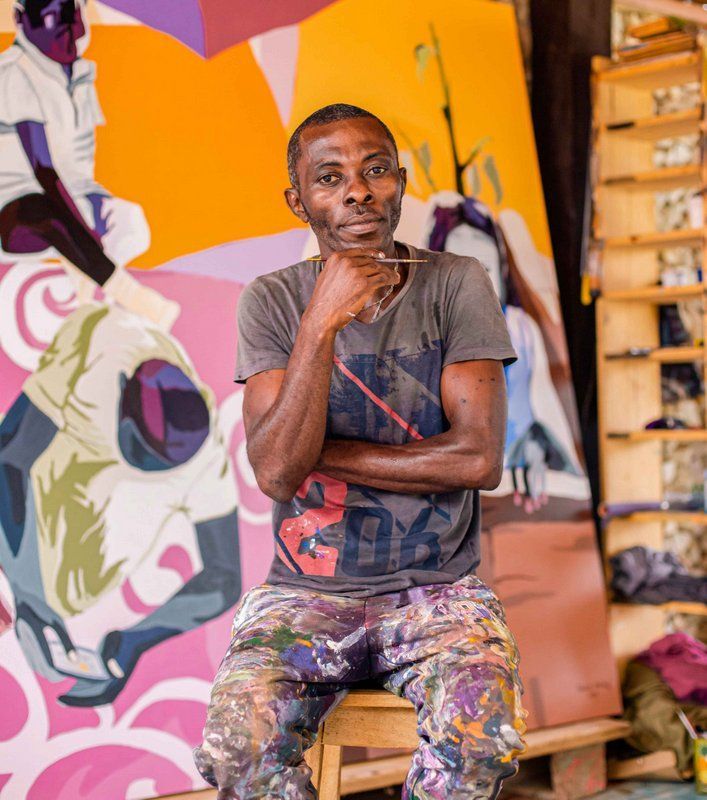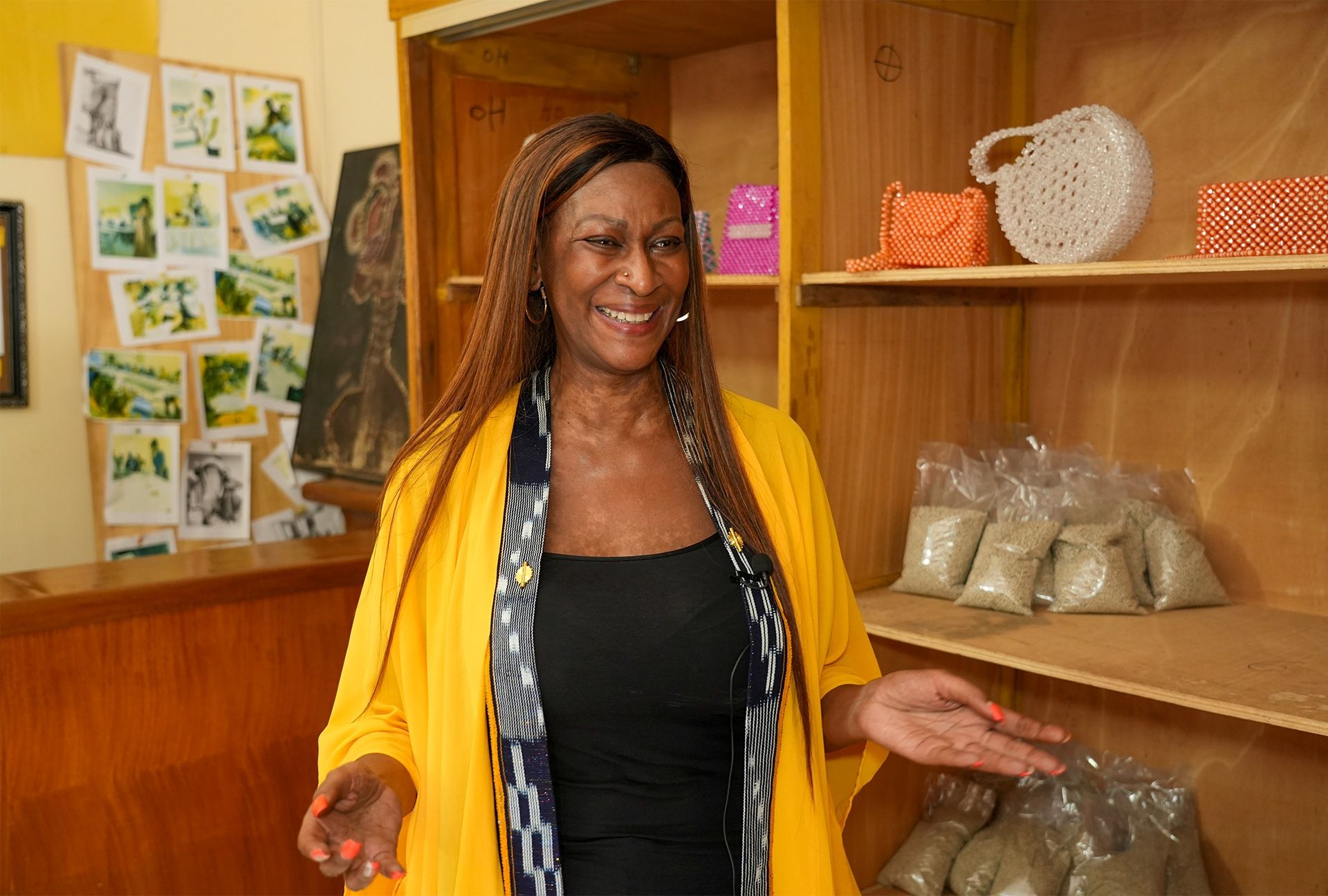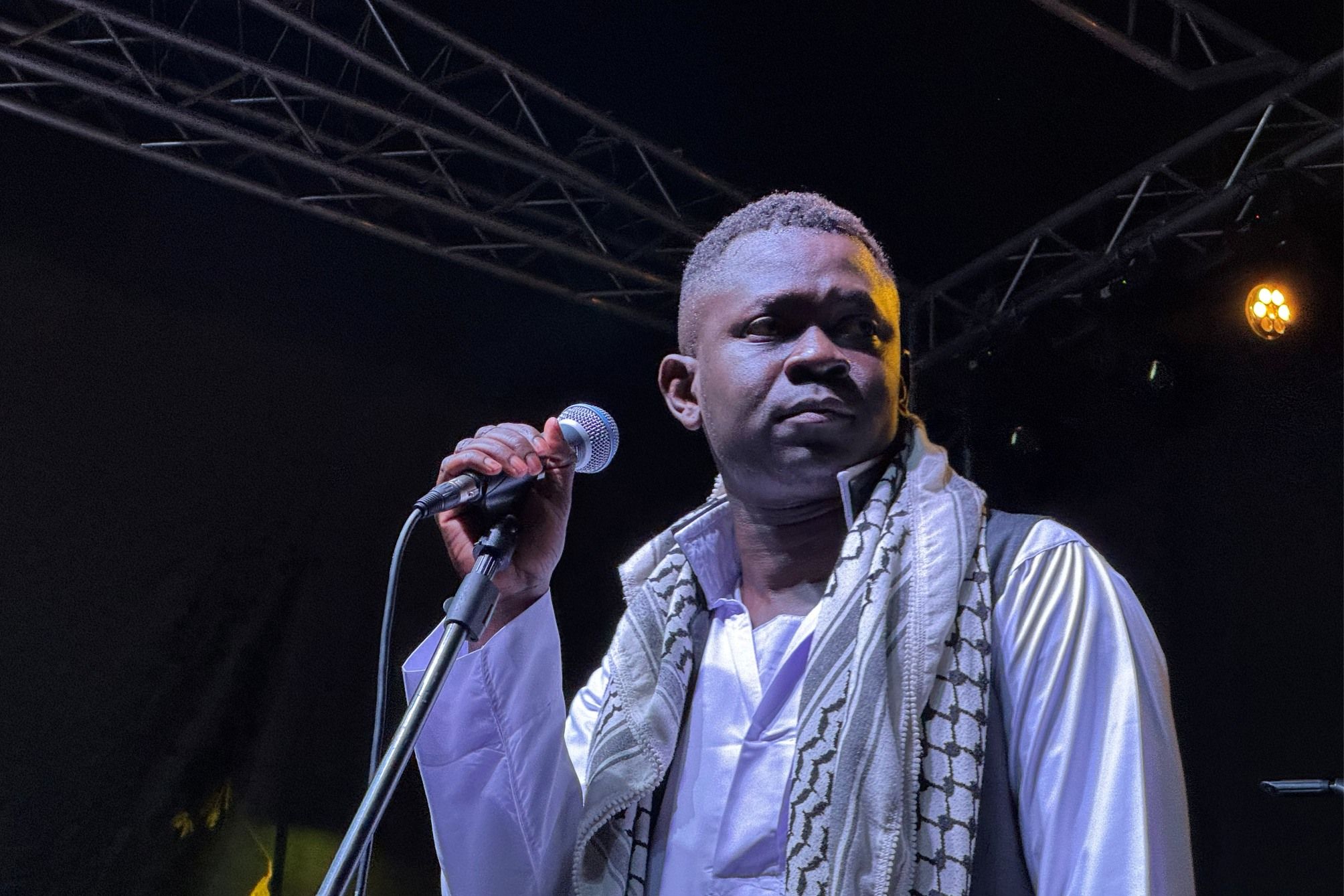A chance encounter at the fish store where he worked led Franco Ndiba to drop his fillet knife for a paintbrush. Today, the artist is making international waves in the contemporary art scene.

By Patrick Nelle, bird Story Agency
The characters are faceless and anonymous, yet these attention-grabbing outlines, which seem like flip-flopping silhouettes, conjure a lasting image of being one and everyone simultaneously.
This artistic fantasy of facelessness stirs the imagination. It leaves the mind roving in what 39-year-old Cameroonian artist Franco Ndiba calls his world of “Fantasia”.
“Through this form of art, I invite you into a journey of discovery, experience, and introspection as you peel the attitude, feelings, and perhaps the thinking of the characters in the painting,” he says.
Ndiba, whose works paintings are on display at the Annie Kadji Art Gallery in Doula under the theme Introspection, is one of the contemporary African artists who has gained global recognition.
He has presented two solo shows at Jack Bell Gallery in London – 'Style Boys' in 2021 and 'Kongossa' in 2022. The gallery also exhibited his work at the 2021 and 2022 editions of 1-54 Contemporary African Art Fair, the leading international art fair dedicated to contemporary art from Africa and its diaspora.
The London exhibitions represented a milestone in Ndiba’s journey, propelling his art beyond Cameroon boundaries for the first time and setting his name on the international art market.
While most African artists dream of having their works shown and sold in a European gallery, Ndiba warns that it would be a mistake “to neglect your local audience just because you have gone international”.
He describes his current exhibition in Douala with a local gallery as one of his greatest achievements, no less important than having dealt with London art galleries.
And so, in a white cube full of his colourful canvases at the Annie Kadji Art gallery, he takes us through his journey into the art world.

Ndiba, the fishmonger
Born in Douala in 1983, Ndiba grew up in the Bepanda Omnisport neighbourhood, which takes its name from the Reunification Stadium, a famous soccer stadium in the country. Unlike many youths in Douala, who dreamt of following in the footsteps of legendary footballers like Roger Milla and Samuel Eto, Ndiba was only drawn to art.
As a teenager, he prematurely quit school following a dispute with his father. This led him to enter the workforce at a relatively early age, and he was hired as a seller in a fish store. But the fish shop turned out to be a blessing in disguise.
His work ran from 9 am to 7 pm, and in between, there were moments when there were no customers. During such breaks, he would grab a pencil and pad to scribble some sketches.
One of the shop’s regular customers was Nga Daybor, a Cameroonian painter who, at the time, owned a silk-screening workshop in the Cité Cicam neighbourhood.
Daybor tells us about this encounter:
“Ndiba was a friend of a friend of mine, so anytime I went there we would engage. I noticed his artistic skill.”
When Daybor offered to hire him as a studio assistant, Ndiba jumped at the chance because it would allow him to express his passion for art.
This was his home and training ground for four years.
“Though I was able to draw, I still had huge gaps in my knowledge. Daybor helped me to improve my drawing techniques. For example, he taught me how to respect proportion when making a portrait among other technical and artistic elements... He taught me a number of basics,” says Ndiba.

Ndiba, the apprentice
Ndiba's growth was the result of a long process made of influences and teachings from other big names in the Cameroonian art scene, from which he had the opportunity to learn.
“I was inspired by Daybor’s work while I was working in his studio. I was also guided by Hervé Youmbi who, through his sound advice, had a great influence on my style.”
One of his artworks, on display at Daybor studio, was selected to feature at a local art exhibition, drawing attention to his art.
“I do not exactly remember how it happened, but one of my works was in Daybor’s workshop when a curator was touring some artist studios in order to pick some artworks for a scheduled large collective art exhibition on the Cameroon national day in 2012. It was organised by the Ministry of Culture,” he says.
From then, his works started to be regularly selected in various collective art shows, but that didn’t automatically translate into regular revenue.
“You have to be very resilient when you decide to become an artist. In my family, many pushed me to get what they considered a real job instead,” he remembers. He confesses having been plagued with doubt, having questioned himself about the rightness of his choice.
“There are setbacks on this path. Sometimes you have some promises that raise your expectations, only to be disappointed at the end of the day,” he says.
As art is boundless, he also looked for ideas abroad, from European classic artists.
“I was deeply touched by works of Frenchman Paul Cézanne, as well as those of Portuguese abstract painter, Maria Helena Vieira da Silva.”
Based on these inspirations, Ndiba's works in 2016 explored the theme of urbanisation and tried to draw attention to the unchecked development of constructions and houses in Douala’s neighbourhoods.
Ndiba, the international artist
In 2017, Ndiba was hired by Ajarb Bernard, a renown Cameroonian artist, as an assistant. Bernard, whose reputation was growing outside the country and had just signed a deal with Jack Bell Gallery in London, needed help to cope with his growing number of clients. That collaboration would prove to be a massive boost for Ndiba’s career.
“Ndiba is a hard worker, and I had made the promise to do my best to help him and to make him benefit from the same chances I had,” Bernard tells us through a WhatsApp call.
Taking his chances, Ndiba would frantically send Bernard multiple screenshots every time he painted new works.

“One day, Ndiba sent some work that I immediately felt would catch the eye of the gallery in London, so I shared it with them. I had no doubt they would love it, and that is what happened,” recalls Bernard.
In 2021, Jack Bell Gallery commissioned Ndiba for ten pieces of art.
“Out of the ten pieces, eight were sold. This represented my largest and biggest sales ever,” Ndiba reveals.
Ndiba’s works, which gained attention from art lovers in London, were centred on the theme of a banana skin. The paintings depicted people eating bananas and carelessly throwing the peels.
"This was a call to society to take care of the environment and keep it clean," he explains.
Ndiba plans more works and exhibitions in the future. In the meantime, through their organisation named Futura and with his friend Daybor and other colleagues, he will keep promoting and mentoring young people willing to embrace visual arts.
bird




